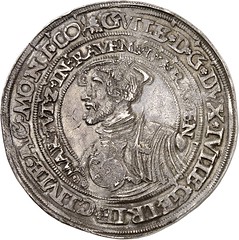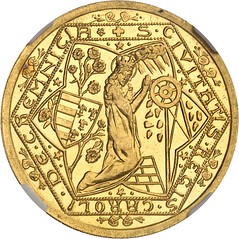
PREV ARTICLE
NEXT ARTICLE
FULL ISSUE
KüNKER SALE 400 HIGHLIGHTSKünker's auction sale 400 closes February 1st. Here's the press release. Some nice coins. -Editor Künker's 400th Auction Sale: A Firework of Numismatics On 1 February 2024, the World Money Fair kicks off with Künker's 400th auction. Look forward to a firework of rare coins and medals! 770 lots with a total estimate of more than 7 million euros – do you even need to hear more to get excited about Künker's 400th auction sale that kicks off the World Money Fair on 1 February 2024? Yes, you do! After all, the Osnabrück auction house will once again offer a selection of exquisite coins and medals that are hardly ever found on the market.
Selected lösers from the Popken Collection No. 2: Brunswick and Lüneburg. Julius, 1568-1589. 1583 löser of 10 reichstalers, Heinrichstadt (Wolfenbüttel). From the Friedrich Popken Collection. Extremely rare. Very fine. Estimate: 50,000 euros No. 16: Brunswick and Lüneburg. Rudolph Augustus, 1666-1685. 1679 löser of 3 reichstalers, Zellerfeld. From the Friedrich Popken Collection. Extremely rare. Extremely fine. Estimate: 40,000 euros
Rarities from the German States No. 64: Bavaria. Ludwig I, 1825-1848. 1830 ducat. Danube river gold. Very rare. Extremely fine to FDC. Estimate: 15,000 euros No. 82: Brandenburg-Prussia. Frederick William, the Great Elector, 1640-1688. 1684 reichstaler IE, Magdeburg. Very rare. About FDC. Estimate: 40,000 euros No. 131: Hamburg. 1/4 portugalöser worth 2 1/2 ducats n.d. (1578-1582) NGC MS61. Very rare. Extremely fine +. Estimate: 20,000 euros No. 149: Jülich-Berg. William V, 1539-1592. Taler n.d. (ca. 1540), Mülheim. Extremely rare. Extremely fine. Estimate: 35,000 euros No. 163: Lippe. Simon Henry, 1666-1697. 4 ducats 1685 (minted in 1685/86), Detmold. From the dies of the ducat. Extremely rare. Extremely fine. Estimate: 60,000 euros No. 241: Saxe-Hildburghausen. Ernst, 1680-1715. 1708 reichstaler, probably Coburg mint. Probably the 2nd known specimen. Extremely fine. Estimate: 35,000 euros No. 281: Württemberg. Julius Frederick, administrator and guardian of Eberhard III, 1631-1633. 1631 reichstaler, Stuttgart. Very rare. About extremely fine. Estimate: 25,000 euros
French Showpieces Our second example was created in the county of Dombes under the rule of Louis III de Bourbon-Montpensier, one of the great opponents of the Huguenots. He played an active role in the run up to Bartholomew's Day massacre. Almost even more remarkable than the general on the obverse are the minting tools and the circumscription on the reverse, which explains that workers at mints can pass without paying taxes. No. 460: France. Louis XIII, 1610-1643. 1640 double louis d'or 1640, Paris. Very rare. Extremely fine. Estimate: 40,000 euros No. 481: France. Dombes. Louis II de Bourbon-Montpensier, 1560-1582. 1576 ecu d'argent. Probably the 2nd known specimen. Very fine to extremely fine. Estimate: 25,000 euros
British Multiple Gold Coins No. 494: Great Britain. William III, 1694-1702. 5 guineas 1701, London. Rare. NGC MS61. Extremely fine to FDC. Estimate: 60,000 euros No. 497: Great Britain. George III, 1760-1820. Pattern 5 pounds 1820, London. Pattern with smooth edge. NGC PF64*CAMEO (Top Pop). Only two specimens known. Proof. Estimate: 150,000 euros
Italy from Frederick II to Victor Emmanuel III No. 512: Como. Frederick II, 1250-1280. Grosso da 6 denari n.d. Very rare. About extremely fine. Estimate: 10,000 euros No. 523: Milan. Charles V, 1535-1556. Testone n.d. Commemorating the senate of Milan paying homage to the emperor. Very rare. About extremely fine. Estimate: 6,000 euros No. 529: Naples and Sicily. Joachim Murat, King of Naples, 1808-1815. 40 franchi 1810, Naples. Variety without N.M. at the neck section. NGC AU55 (Top Pop). Extremely rare. Extremely fine. Estimate: 75,000 euros No. 553: Kingdom of Italy. Victor Emmanuel III, 1900-1946. 5 lire 1901, Rome. Very rare. About FDC. Estimate: 50,000 euros
Poland, Russia, Czechia, Transylvania Let us begin with an example from Poland, a gold medal by Sigismund III Vasa, the Swedish king on the Polish throne. The wonderful medal created in the late Renaissance period depicts the baptism of Jesus in the Jordan River on the reverse. This motif was a unique compromise for the ruler, who governed Protestant Sweden and Catholic Poland at the same time. The two examples from Russia that will be presented here are among the rarest pieces of Russian numismatics. The 1801 ruble is a pattern from St. Petersburg. Regarding its fineness, the 37 1/2 rubles from 1902 exactly corresponded to 100 francs of the Latin Monetary Union. Only 225 specimens were issued to be used as gifts. There is a lot on offer for Czech collectors, including numerous gold coins from Czechoslovakia as well as a royal d'or by John of Luxembourg from 1337. The blind king, who fell at the Battle of Crécy, was the father of Charles IV. This royal d'or is the only specimen on the market. Let us round off our trip to Eastern Europe with a 10-fold ducat by Sigismund Rákóczi, the flamboyant figure of Transylvanian history that owed his title both to the recognition of the imperial court and that of the Ottoman sultan. Particularly remarkable is the weapon the hero of the Long Turkish War carries on this coin: a mace. No. 584: Poland. Sigismund III, 1587-1632. 1596 gold medal of 5 ducats, probably Poznan. NGC AU58 (Top Pop). Extremely rare. About extremely fine. Estimate: 100,000 euros No. 593: Poland. Torun. 2 ducats 1664. PCGS MS63 (Top Pop). Very rare. Extremely fine to FDC. Estimate: 50,000 euros No. 631: Russia. Alexander I, 1801-1825. 1801 ruble, St. Petersburg. Pattern. Very rare. Extremely fine to FDC. Estimate: 100,000 euros No. 642: Russia. Nicholas II, 1894-1917. 37 1/2 rubles (100 francs) 1902, St. Petersburg. Only 225 specimens minted. First strike, about FDC. Estimate: 150,000 euros No. 686: Czechia / Bohemia-Moravia. John of Luxembourg, 1310-1346. Royal d'or n.d. (1337), minted for the County of Luxembourg. The only specimen on the market. Extremely fine. Estimate: 75,000 euros No. 700: Czechoslovakia. 5 ducats 1934, Kremnica, commemorating the re-opening of the Kremnica mines. Original strike. NGC 63PL. Only 70 specimens minted. First strike, about FDC. Estimate: 10,000 euros No. 705: Hungary / Transylvania. Sigismund Rákóczi, 1607-1608. 10 ducats 1607. NGC AU55+. Extremely rare. About extremely fine. Estimate: 100,000 euros
Far East and the USA The auction will be rounded off by a small series of US gold coins. No. 719: China. Republic. 1 dollar year 12 (1923), probably for the wedding of the former ruler Henry Pu Yi. NGC MS61. Very rare. Extremely fine to FDC. Estimate: 20,000 euros No. 725: Japan. Man'en era. Oban without year (1860-1862). Very rare. Extremely fine. Estimate: 12,500 euros No. 760: USA. 20 dollars 1907, Philadelphia. High relief. Very rare. About FDC. Estimate: 10,000 euros
In the context of the Berlin auction sale, on 5 and 6 February 2024 Künker's eLive Premium Auction 401 will be held showcasing coins and medals featuring To order a catalog contact Künker, Nobbenburger Straße 4a, 49076 Osnabrück; phone: +49 541 / 962020; fax: +49 541 / 9620222; or via e-mail: service@kuenker.de. You can access the auction catalogs online at www.kuenker.de. If you want to submit your bid from your computer at home, please remember to register for this service in good time.
Wayne Homren, Editor The Numismatic Bibliomania Society is a non-profit organization promoting numismatic literature. See our web site at coinbooks.org. To submit items for publication in The E-Sylum, write to the Editor at this address: whomren@gmail.com To subscribe go to: https://my.binhost.com/lists/listinfo/esylum All Rights Reserved. NBS Home Page Contact the NBS webmaster 
|
























































